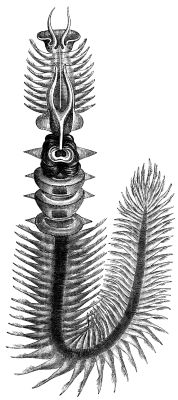photoproteins on:
[Wikipedia]
[Google]
[Amazon]
Photoproteins are a type of
 The term photoprotein was first used to describe the unusual chemistry of the luminescent system of ''
The term photoprotein was first used to describe the unusual chemistry of the luminescent system of ''
enzyme
Enzymes () are proteins that act as biological catalysts by accelerating chemical reactions. The molecules upon which enzymes may act are called substrates, and the enzyme converts the substrates into different molecules known as products. A ...
, made of protein
Proteins are large biomolecules and macromolecules that comprise one or more long chains of amino acid residues. Proteins perform a vast array of functions within organisms, including catalysing metabolic reactions, DNA replication, respo ...
, from bioluminescent
Bioluminescence is the production and emission of light by living organisms. It is a form of chemiluminescence. Bioluminescence occurs widely in marine vertebrates and invertebrates, as well as in some Fungus, fungi, microorganisms including ...
organisms. They add to the function of the luciferins
Luciferin (from the Latin ''lucifer'', "light-bearer") is a generic term for the light-emitting Chemical compound, compound found in organisms that generate bioluminescence. Luciferins typically undergo an enzyme-catalyzed reaction with Oxygen, m ...
whose usual light-producing reaction is catalyzed
Catalysis () is the process of increasing the rate of a chemical reaction by adding a substance known as a catalyst (). Catalysts are not consumed in the reaction and remain unchanged after it. If the reaction is rapid and the catalyst recyc ...
by the enzyme luciferase
Luciferase is a generic term for the class of oxidative enzymes that produce bioluminescence, and is usually distinguished from a photoprotein. The name was first used by Raphaël Dubois who invented the words ''luciferin'' and ''luciferase'', ...
.
History
 The term photoprotein was first used to describe the unusual chemistry of the luminescent system of ''
The term photoprotein was first used to describe the unusual chemistry of the luminescent system of ''Chaetopterus
''Chaetopterus'' or the parchment worm or parchment tube worm is a genus of marine polychaete worm that lives in a tube it constructs in sediments or attaches to a rocky or coral reef substrate. The common name arises from the parchment-like app ...
'' (a marine Polychaete
Polychaeta () is a paraphyletic class (biology), class of generally marine invertebrate, marine annelid worms, common name, commonly called bristle worms or polychaetes (). Each body segment has a pair of fleshy protrusions called parapodia that ...
worm). This was meant to distinguish them from other light-producing proteins because these do not exhibit the usual luciferin
Luciferin (from the Latin ''lucifer'', "light-bearer") is a generic term for the light-emitting compound found in organisms that generate bioluminescence. Luciferins typically undergo an enzyme-catalyzed reaction with molecular oxygen. The result ...
-luciferase
Luciferase is a generic term for the class of oxidative enzymes that produce bioluminescence, and is usually distinguished from a photoprotein. The name was first used by Raphaël Dubois who invented the words ''luciferin'' and ''luciferase'', ...
reaction.
Reaction kinetics
Photoproteins do not display typicalenzyme kinetics
Enzyme kinetics is the study of the rates of enzyme-catalysed chemical reactions. In enzyme kinetics, the reaction rate is measured and the effects of varying the conditions of the reaction are investigated. Studying an enzyme's kinetics in th ...
as seen in luciferases. Instead, when mixed with luciferin, they display luminescence proportional to the amount of the photoprotein. For example, the photoprotein aequorin
Aequorin is a calcium-activated photoprotein isolated from the hydrozoan ''Aequorea victoria''. Its bioluminescence was studied decades before the protein was isolated from the animal by Osamu Shimomura in 1962. In the animal, the protein occur ...
produces a flash of light when luciferin and calcium are added, rather than the prolonged glow that is seen for luciferases when luciferin is added. In this respect, it may appear that photoproteins are not enzymes, when in fact they do catalyze
Catalysis () is the process of increasing the rate of a chemical reaction by adding a substance known as a catalyst (). Catalysts are not consumed in the reaction and remain unchanged after it. If the reaction is rapid and the catalyst recyc ...
their bioluminescence reactions. This is due to a fast catalytic step, which produces the light, and a slow regeneration step, where the oxyluciferin is freed and another molecule of luciferin is then enabled to bind to the enzyme. Because of the kinetically slow step, each aequorin molecule must "recharge" with another molecule of luciferin
Luciferin (from the Latin ''lucifer'', "light-bearer") is a generic term for the light-emitting compound found in organisms that generate bioluminescence. Luciferins typically undergo an enzyme-catalyzed reaction with molecular oxygen. The result ...
before it can emit light again, and this makes it appear as though it is not behaving as a typical enzyme.
Photoproteins form a stable luciferin-photoprotein complex, often until the addition of another required factor such as Ca2+ in the case of aequorin
Aequorin is a calcium-activated photoprotein isolated from the hydrozoan ''Aequorea victoria''. Its bioluminescence was studied decades before the protein was isolated from the animal by Osamu Shimomura in 1962. In the animal, the protein occur ...
.
References
{{reflist Bioluminescence Proteins